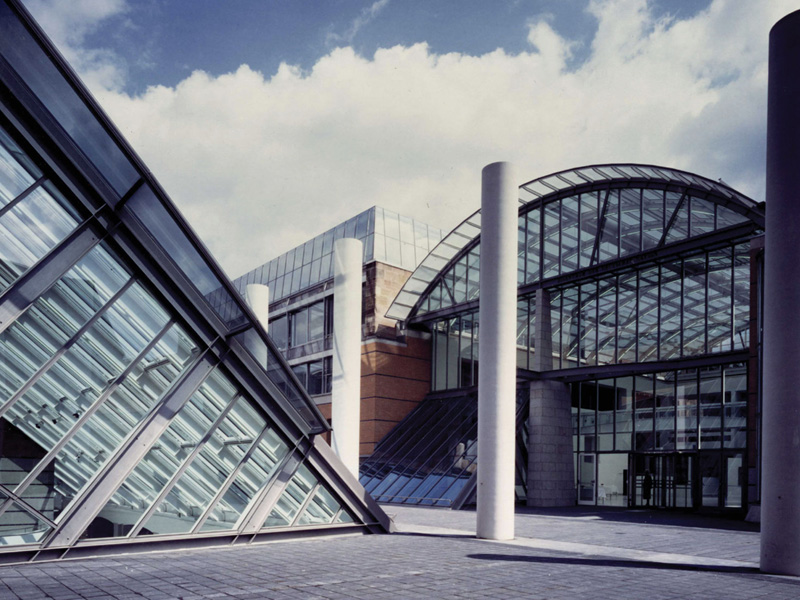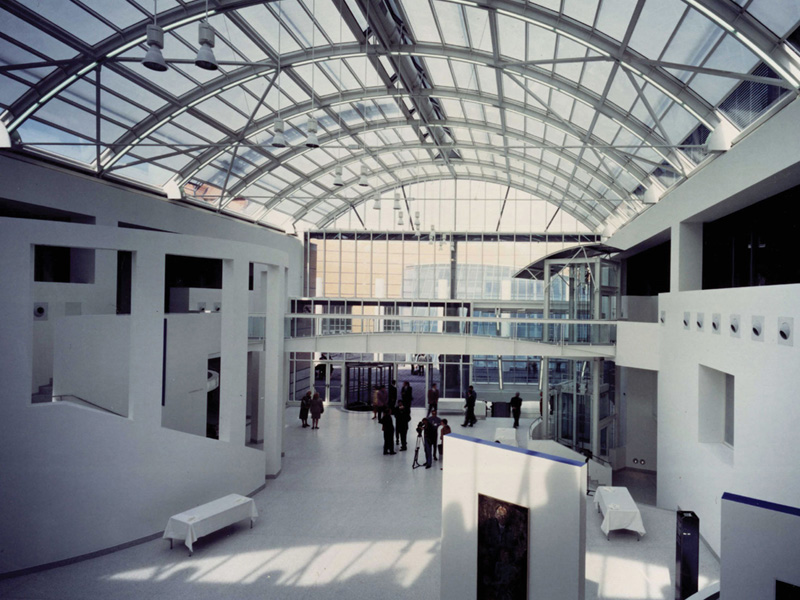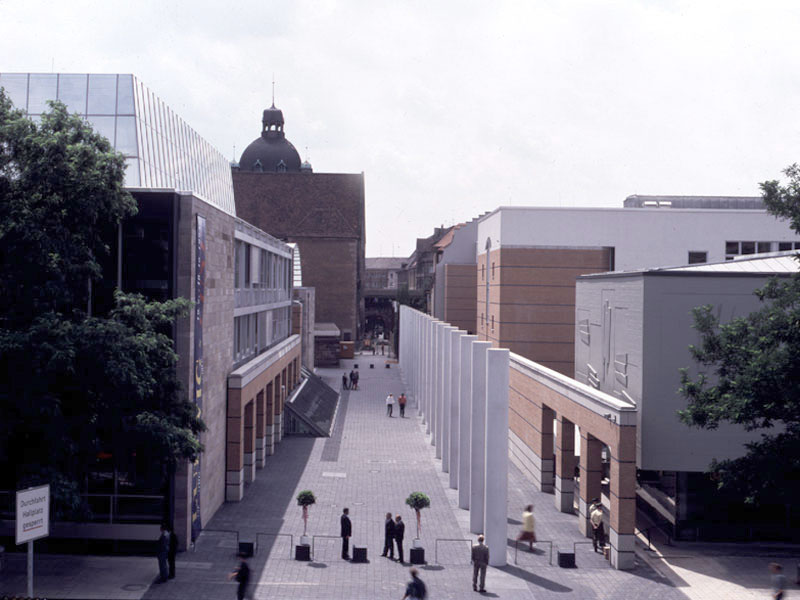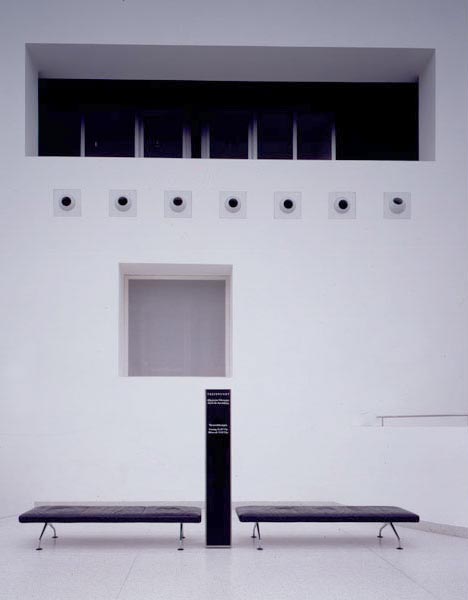Innovative Architektur seit 1970
Germanisches Nationalmuseum – Nürnberg






Erweiterung des Germanischen Nationalmuseums
Mit der 1993 fertiggestellten Erweiterung erhielt der Komplex des Germanischen Nationalmuseums einen weiteren, zeitgenössischen Baustein hinzu. Die Geschichte seiner Architektur spannt sich damit vom Mittelalter bis in die Gegenwart. Von der bei seiner Gründung 1857 vorhandenen Klosterarchitektur des 14. Jahrhunderts, über die Um-, An- und Neubauten des späten 19. und frühen 20. Jahrhunderts, die Nachkriegsbauten von Sep Ruf bis hin zu der seit 1988 in vier Abschnitten von me di um Architekten realisierten Maßnahmen. Diese umfassten nicht nur die Errichtung des Kartäuserbaus und die in den Bestand integrierte neue Eingangshalle, sondern auch das beide Teile verbindende Museumsforum. Außerdem wurde die Bibliothek umgebaut und aufgestockt, der Theodor-Heuss-Bau saniert, sowie neue Arbeits- und Unterrichtsräume für das kunstpädagogische Zentrum geschaffen.
Die zentrale Entwurfsidee beruht auf dem Erhalt der durch das Museum laufenden Kartäusergasse und ihrer Ausbildung als „Brücke“, die als öffentlicher Raum durch das Museum führt und dadurch eine unterirdische, zusammenhängende Erschließung ermöglicht.
Um den stadträumlichen und funktionellen Anforderungen zu entsprechen, erfolgte die Verlegung des Haupteingangs vom Kornmarkt in die Kartäusergasse. Diese wurde nach einem Entwurf des Künstlers Dani Karavan als „Strasse der Menschenrechte“ gestaltet. Ein Torbau und 27 Rundpfeiler, zwei Bodenplatten und ein Baum, aneinandergereiht aufgestellt, stehen für die 30 Artikel der Menschenrechtskonvention der Vereinten Nationen. Die Toranlage am Kornmarkt markiert den Eintritt in den Museumsbereich und bildet zugleich das Gegenstück zum Kartäusertor.
Das kommunikative Zentrum des Erweiterungsbaus ist das Museumsforum. Unter der Kartäusergasse liegend, die sich einer Brücke gleich darüberspannt, verbindet es den Kartäuserbau mit der neuen Eingangshalle. Ein großzügiges Glas-Tonnen-Gewölbe erlaubt eine weitestgehend natürliche Belichtung und bietet darüber hinaus die angestrebte Beziehung zwischen öffentlichem (Strassen-) Raum und Ausstellungskomplex. Die Situierung des Forums lässt aber auch eine museumsunabhängige Nutzung zu.
Project Description
Extension of the German National Museum
With its extension completed in 1993, the German National Museum gained a further contemporary addition to the entire museum complex. The history of its architecture now spans from the Middle Ages to the present, from the 14th-century cloister-architecture extant at the time of its foundation in 1857, over the extensions and partial reconstruction of the late 19th and early 20th centuries, as well as the post-war constructions by Sep Ruf, to the new construction undertaken by me di um architects since1988. This not only comprises the erection of the Carthusian building and the new entrance hall integrated into the historical part of the museum, but also the museum forum connecting these two. In addition the library has been rebuilt with storeys added to it, the Theodor Heuss building renovated, and new work-rooms and seminar-rooms have also been created.
The idea central to the project-design was to preserve the Carthusian passage running through the museum, invest it with a bridging function and have it lead through the museum as a public space, thereby enabling the creation of a subterranean connection.
Beyond the bridge, both parts of the museum, hitherto separated by the passage, could be connected in the form of a spacious entrance hall. Following urban and functional demands, the main entrance was moved from the Corn Market into the Carthusian passage and the passage renovated to become the „Street of Human Rights“ in accordance with a design by artist Dani Karavan. A gateway, 27 columns, two flagstone areas and a tree, all in a row, represent the 30 Articles of the Human Rights Convention of the United Nations. The gateway to the Corn Market provides the entrance into the museum area, forming at the same time a counterpart to the Carthusian gate.
The communicative center of the extension is the museum forum. Located beneath the Carthusian passage „bridge“, it connects the Carthusian building with the new main entrance hall. A generous steel-and-glass, barrel-vaulted ceiling allows in the maximum of light and provides the relationship striven for between public (street) space and exhibition complex. The positioning of the forum also allows for utilization independent of the museum.
Erweiterung des Germanischen Nationalmuseums
Nürnberg
Wettbewerb 1983 – 1. Preis
Fertigstellung 1993
BGF 4.300 qm
Extension of the German National Museum
Nürnberg
Competition 1983 – 1st prize
Completion 1993
BGF 4.300 qm

Erweiterung des Germanischen Nationalmuseums
Nürnberg
Wettbewerb 1983 – 1. Preis
Fertigstellung 1993
BGF 4.300 qm
Extension of the German National Museum
Nürnberg
Competition 1983 – 1st prize
Completion 1993
BGF 4.300 qm





Projektbeschreibung
Erweiterung des Germanischen Nationalmuseums
Mit der 1993 fertiggestellten Erweiterung erhielt der Komplex des Germanischen Nationalmuseums einen weiteren, zeitgenössischen Baustein hinzu. Die Geschichte seiner Architektur spannt sich damit vom Mittelalter bis in die Gegenwart. Von der bei seiner Gründung 1857 vorhandenen Klosterarchitektur des 14. Jahrhunderts, über die Um-, An- und Neubauten des späten 19. und frühen 20. Jahrhunderts, die Nachkriegsbauten von Sep Ruf bis hin zu der seit 1988 in vier Abschnitten von me di um Architekten realisierten Maßnahmen. Diese umfassten nicht nur die Errichtung des Kartäuserbaus und die in den Bestand integrierte neue Eingangshalle, sondern auch das beide Teile verbindende Museumsforum. Außerdem wurde die Bibliothek umgebaut und aufgestockt, der Theodor-Heuss-Bau saniert, sowie neue Arbeits- und Unterrichtsräume für das kunstpädagogische Zentrum geschaffen.
Die zentrale Entwurfsidee beruht auf dem Erhalt der durch das Museum laufenden Kartäusergasse und ihrer Ausbildung als „Brücke“, die als öffentlicher Raum durch das Museum führt und dadurch eine unterirdische, zusammenhängende Erschließung ermöglicht.
Um den stadträumlichen und funktionellen Anforderungen zu entsprechen, erfolgte die Verlegung des Haupteingangs vom Kornmarkt in die Kartäusergasse. Diese wurde nach einem Entwurf des Künstlers Dani Karavan als „Strasse der Menschenrechte“ gestaltet. Ein Torbau und 27 Rundpfeiler, zwei Bodenplatten und ein Baum, aneinandergereiht aufgestellt, stehen für die 30 Artikel der Menschenrechtskonvention der Vereinten Nationen. Die Toranlage am Kornmarkt markiert den Eintritt in den Museumsbereich und bildet zugleich das Gegenstück zum Kartäusertor.
Das kommunikative Zentrum des Erweiterungsbaus ist das Museumsforum. Unter der Kartäusergasse liegend, die sich einer Brücke gleich darüberspannt, verbindet es den Kartäuserbau mit der neuen Eingangshalle. Ein großzügiges Glas-Tonnen-Gewölbe erlaubt eine weitestgehend natürliche Belichtung und bietet darüber hinaus die angestrebte Beziehung zwischen öffentlichem (Strassen-) Raum und Ausstellungskomplex. Die Situierung des Forums lässt aber auch eine museumsunabhängige Nutzung zu.
Project Description
Extension of the German National Museum
With its extension completed in 1993, the German National Museum gained a further contemporary addition to the entire museum complex. The history of its architecture now spans from the Middle Ages to the present, from the 14th-century cloister-architecture extant at the time of its foundation in 1857, over the extensions and partial reconstruction of the late 19th and early 20th centuries, as well as the post-war constructions by Sep Ruf, to the new construction undertaken by me di um architects since1988. This not only comprises the erection of the Carthusian building and the new entrance hall integrated into the historical part of the museum, but also the museum forum connecting these two. In addition the library has been rebuilt with storeys added to it, the Theodor Heuss building renovated, and new work-rooms and seminar-rooms have also been created.
The idea central to the project-design was to preserve the Carthusian passage running through the museum, invest it with a bridging function and have it lead through the museum as a public space, thereby enabling the creation of a subterranean connection.
Beyond the bridge, both parts of the museum, hitherto separated by the passage, could be connected in the form of a spacious entrance hall. Following urban and functional demands, the main entrance was moved from the Corn Market into the Carthusian passage and the passage renovated to become the „Street of Human Rights“ in accordance with a design by artist Dani Karavan. A gateway, 27 columns, two flagstone areas and a tree, all in a row, represent the 30 Articles of the Human Rights Convention of the United Nations. The gateway to the Corn Market provides the entrance into the museum area, forming at the same time a counterpart to the Carthusian gate.
The communicative center of the extension is the museum forum. Located beneath the Carthusian passage „bridge“, it connects the Carthusian building with the new main entrance hall. A generous steel-and-glass, barrel-vaulted ceiling allows in the maximum of light and provides the relationship striven for between public (street) space and exhibition complex. The positioning of the forum also allows for utilization independent of the museum.

